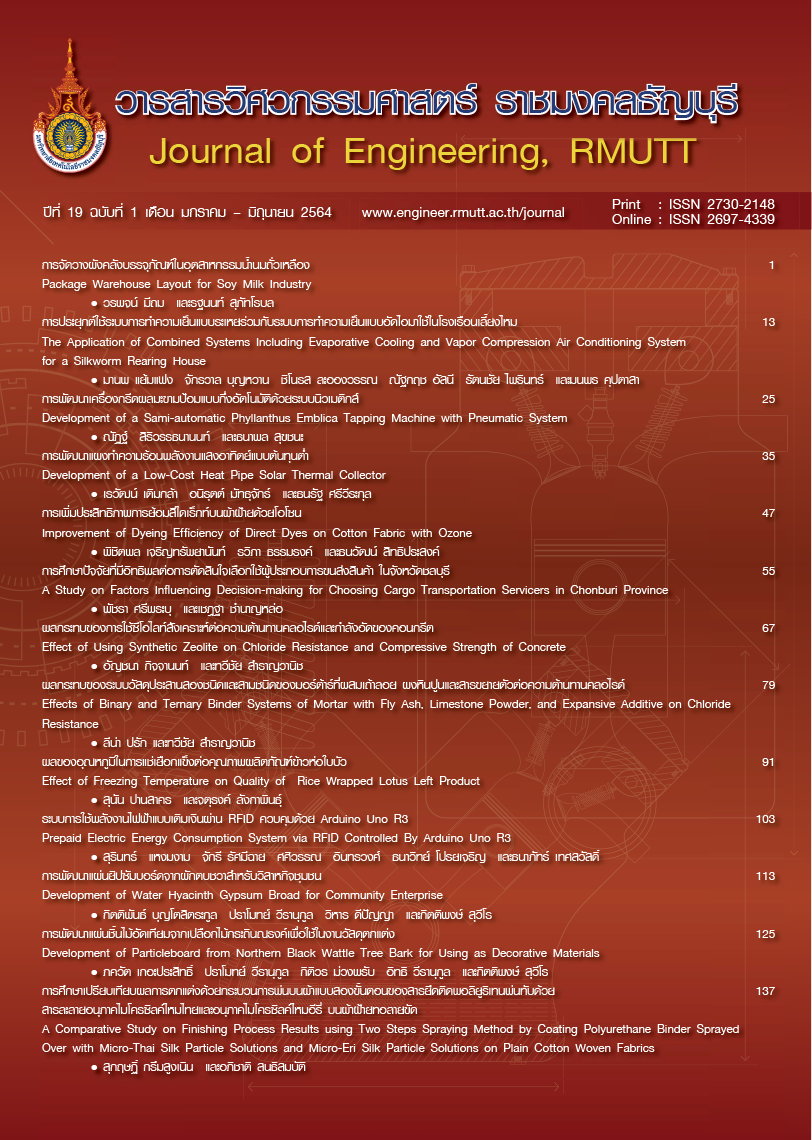Effects of Binary and Ternary Binder Systems of Mortar with Fly Ash, Limestone Powder, and Expansive Additive on Chloride Resistance
Main Article Content
Abstract
This paper aims to study the effect of binary and ternary binder system in mortars on chloride resistance. The study used fly ash (FA), limestone powder (LP), and expansive additive (EA) as partial cement replacement materials in mortars. Ordinary Portland cement type I was used as the main binder. Water-to-binder ratios were kept at 0.40 and 0.50. The FA and LP partially replaced the binder at percentages ranging from 5% to 30%, and EA partially replaced the binder at 10%. The chloride resistances of binary and ternary binder mortars were investigated. Rapid chloride penetration, rapid chloride migration and bulk chloride diffusion of mortars were tested. The study showed that the use of FA as a supplementary material of binder in mortar (binary binder system) can reduce the charge passed, chloride penetration depth, and chloride diffusion coefficient of the mortar under chloride ingress. The binary binder mortar with FA exhibited the highest chloride resistance. Furthermore, the mortar with FA and LP (ternary binder system) at appropriate proportions displayed good chloride resistance results.
Article Details
The manuscript, information, content, picture and so forth which were published on Frontiers in engineering innovation research has been a copyright of this journal only. There is not allow anyone or any organize to duplicate all content or some document for unethical publication.
References
Sumranwanich T, Tangtermsirikul S. A model for predicting time-dependent chloride binding capacity of cement-fly ash cementitious system. Materials and Structures. 2004;37:387-96.
Angst U. Chloride induced reinforcement corrosion in concrete. Thesis for the degree of Philosophiae Doctor, Faculty of Engineering Science and Technology, Norwegian University of Science and Technology, Norway, 2011.
Rissardi CZ, de Souza CFN, Pacheco F, Christ R, Silveira LF. Chloride attack evaluation on concrete compositions according to Brazilian standard ABNT NBR 6118 specification. J Build Rehabil. 2016;1(19):1-12.
Prak L, Sumranwanich T. Investigation of chloride penetration and steel corrosion in repaired concrete after exposure to marine environment of Thailand. Journal of Engineering, RMUTT. 2020;18(1):165-73.
Thomas M. Chloride thresholds in marine concrete. Cement and Concrete Research. 1996;26(4):513-19.
Jena T, Panda KC. Mechanical and durability properties of marine concrete using fly ash and silpozz. Advances in Concrete Construction. 2018;6(1):47-68.
Zunino F, Boehm–Courjault E, Scrivener K. The impact of calcite impurities in clays containing kaolinite on their reactivity in cement after calcination. Materials and Structures. 2020;53(44):1-15.
Mehta PK. Studies on blended Portland cements containing Santorin earth. Cement and Concrete Research. 1981;11(4):507-18.
Mehta PK, Monterio P.J.M. Concrete: Microstructure. Properties and Materials. (3rd Edition), The McGraw-Hill Companies. 2006.
Massazza F. Pozzolanic cements. Cement and Concrete Composites. 1993;15(4):185-214.
Chindaprasirt P, Jaturapitakkul C, Sinsiri, T. Effect of fly ash fineness on microstructure of blended cement paste. Construction and Building Materials. 2007;21(4):1534-41.
Nguyen C.V, Lambert P, Bui V.N. Effect of locally sourced pozzolan on corrosion resistance of steel in reinforced concrete beams. International Journal of Civil Engineering. 2020;18:619-30.
Arttamart S, Sumranwanich T. Compressive strength and chloride penetration resistance of concrete with fly ash, limestone powder and partial replacement of fine aggregate by bottom ash. Journal of Engineering, RMUTT. 2019;17(2):113-25. (in Thai)
Hussain K, Choktaweekarn P, Saengsoy W, Srichan T, Tangtermsirikul S. Effect of cement types, mineral admixtures, and bottom ash on the curing sensitivity of concrete. International Journal of Minerals, Metallurgy and Materials. 2013;20(1):94-105.
Deilami S, Aslani F, Elchalakani M. Durability assessment of self-compacting concrete with fly ash. Advances in Concrete Construction. 2017;19(5):489-99.
Sadrmomtazi A, Tahmouresi B, Amooie M. Permeability and mechanical properties of binary and ternary cementitious mixtures. Advances in Concrete Construction. 2017;5(5):423-36.
Naik TR, Singh SS, Hossain MM. Properties of high-performance concrete systems incorporating large amounts of high-lime fly ash. Construction and Building Materials. 1995;9(4):195-204.
Praveen Kumar VV, Ravi Prasada D. Influence of supplementary cementitious materials on strength and durability characteristics of concrete. Advances in Concrete Construction. 2019;7(2):75-85.
Juenger MCG, Siddique R. Recent advances in understanding the role of supplementary cementitious materials in concrete. Cement and Concrete Research. 2015;78(1):71-80.
Sunil BM, Manjunatha LS, Lolitha R, Subhash CY. Potential use of mine tailings and fly ash in concrete.Advances in Concrete Construction. 2015;3(1):55-69.
Lawrence P, Cyr M, Ringot E. Mineral admixtures in mortars: effect of inert materials on short term hydration.Cement and Concrete Research. 2003;33(12):1939-47.
Lam NT, Sumranwanich T, Krammart P, Yodmalai D, Sahamitmongkol R, Tangtermsirikul S.Durability properties of concrete with expansive additive. Research and Development Journal. 2008;19(4):8-15.
Liu K, Shui Z, Sun T, Ling G, Li X, Cheng S. Effects of combined expansive agents and supplementary cementitious materials on the mechanical properties, shrinkage and chloride penetration of self-compacting concrete. Construction and Building Materials. 2019;211:120-29.
American society for testing materials. ASTM 1202-97. Standard test method for electrical indication of concrete’s ability to resist chloride ion penetration. Annual Book of ASTM Standard. 2004; Vol. 4.02.
Tang L, Nilsson LO. Chloride diffusivity in high strength concrete at different ages. Nordic Concrete Research. 1992;11(1):162-71.
Otsuki N, Nagataki S, Nakashita K. Evaluation of AgNO3 solution spray method for measurement of chloride penetration into hardened cementitious matrix materials. ACI Materials Journal. 1992;89(6):587-92.
American Society for Testing and Materials. ASTM 1556. Standard test method for determining the apparent chloride diffusion coefficient of cementitious mixtures by bulk diffusion. Annual Book of ASTM Standard. 2004; Vol. 4.02.
American Society for Testing and Materials. ASTM C1152. Standard test method for acid-soluble chloride in mortar and concrete. Annual Book of ASTM Standards. 2004; Vol. 4.02.


